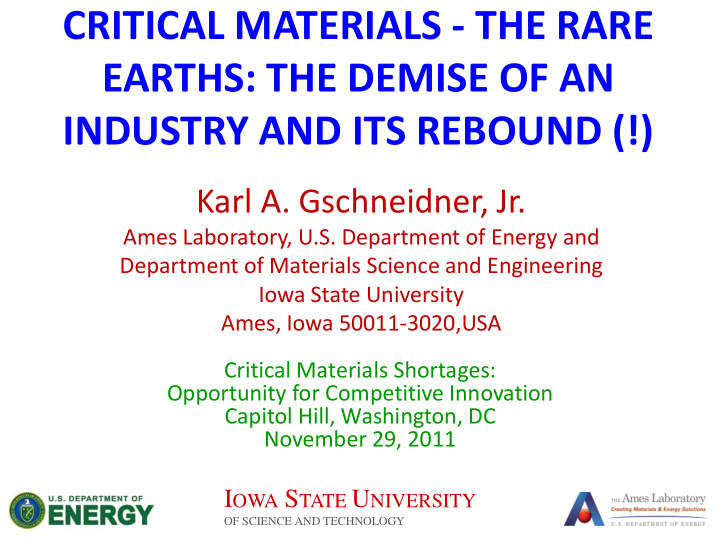



CRITICAL MATERIALS - THE RARE EARTHS: THE DEMISE OF AN INDUSTRY AND ITS REBOUND (!) Karl A. Gschneidner, Jr. Ames Laboratory, U.S. Department of Energy and Department of Materials Science and Engineering Iowa State University Ames, Iowa 50011-3020,USA Critical Materials Shortages: Opportunity for Competitive Innovation Capitol Hill, Washington, DC November 29, 2011 I OWA S TATE U NIVERSITY OF SCIENCE AND TECHNOLOGY
HISTORY In 1980 China had 70% of the known Rare Earth Reserves (18 M metric tons of 26 M metric tons) They made a deliberate effort to control the World Rare Earth Market (1970 → 2000) – successful in early 2000s 1970s: Sold Rare Earth Mineral Concentrates 1980s: Sold Mixed Rare Earth Chemical Concentrates 1990s (early): Sold Separated Rare Earth Oxides and Metals 1990s (late): Sold Magnets, Phosphors, Polishing Compounds 2000s: Sold Finished Products – Electric Motors, Computers, Batteries, LCDs, Cell Phones, etc. 2
MOVING UP THE VALUE CHAIN Step 1: Sold Metals, Compounds on the World Market Step 2: Told the non-Chinese manufacturers they would no longer sell them raw products (metals, compounds) unless they moved their factories to China Step 3: US and World-wide producers closed up their manufacturing facilities, laid-off their employees and many moved to China Step 4: Undercut the rest of the world’s remaining rare earth producers with low prices, even at a loss, to gain markets Result: China controlled over 95% of the rare earths produced in the mid- to late 2000s 3
DEVELOPMENTS IN THE REST OF THE WORLD IN THE MID- TO LATE-2000s Molycorp – only U.S. Mine, located at Mountain Pass, CA Developed a leak in a holding pond in 2002 and the mine was shut down Repaired the leak and passed all state and federal regulations to renew mining Out of operation for about 9 years Restarted mine on January 2, 2011 Rare Earth Industry , lead by Mark Smith of Molycorp Pointed out our military and energy security was in serious jeopardy Military Security All US weapon systems depend on rare earths – especially Nd 2 Fe 14 B permanent magnets in electric motors, computers, guidance systems; phosphors for optical displays Energy Security Electric motors and batteries, wind turbines, petroleum refining, optical displays, fluorescent lighting, oxygen and electrical sensors (automotive engines) 4
THE THREE PARTS OF THE RARE EARTH CRISIS 1. Mining and extraction of the rare earths from the ores to make rare earth concentrates and separated rare earths 2a. Producing rare earth intermediate products: metals, magnets, oxides, chemical compounds, phosphors, catalysts 2b. Manufacturing of rare earth containing devices and other objects: hard drives, electric motors, cell phones, CFLs and long tubes, wind turbines, sensors 3. Replacing the loss of intellectual capital 5
RARE EARTH CRISIS – WHERE DO WE STAND TODAY Part 1: The mining portion is basically solved, just needs time: Molycorp has been mining for nearly one year (since January 2, 2011). Will mine ~6,000 tons in 2011; 20,000 tons in 2012 and 40,000 tons in 2013. Lynas started mining on May 14, 2011 Mound Weld, Australia TODAY America’s Crisis is basically parts 2 and 3 6
PARTS 2 AND 3 OF AMERICA’S (Rest of World’s) CRISIS Rebuilding of rare earth industry, especially beyond mining Smaller mining companies – may need assistance Loan guarantees to help businesses, manufacturers (parts 2a and 2b) get started Tax incentives (federal, state, local) Education and training Need to rebuild and then continuously resupply intellectual capital 7
PRODUCTION OF INTELLECTUAL CAPITAL Annual College Trained Field or Area Personnel Requirements Exploration and evaluation of ores 1-2 Mining and benefication 2-4 concentrates Separation and processing 4-6 mixed and individual REs; recycling Production of primary materials 10-15 metals, starting chemicals, polishing compounds Manufacturing of semi-finished products 15-25 magnets, materials for batteries and catalysts, alloy additives, phosphors Original equipment manufacturers (OEM) 25-50 electric motors, wind turbines, MRI magnets, hard drives cell phones, i-Pods color TV, monitors, laser devices, CFL, long tubes 3-way catalytic converters, fuel cells Totals 59-102 8
FIELDS OF TRAINED SCIENTISTS & ENGINEERS (B.S., M.S., Ph.D., Post-Docs) Chemistry – physical, inorganic, organic, analytical Chemical and metallurgical engineers Material scientists Physical metallurgists Ceramists Condensed matter physicists Electrical, mechanical, industrial engineers Necessary Requirements: Some knowledge of rare earth science, engineering, technology Rare earth courses at a few major universities (e.g. Iowa State University, Colorado School of Mines) Distance learning Short courses 9
SCIENTIFIC & ENGINEERING INFRASTRUCTURE Training students – RESEARCH Scholarships Research projects funding NSF, DOE, DoD, NIST single investigators or small group teams national laboratories and national research centers National Research Center for Rare Earths and Energy • Educational institution with a strong tradition on REs • Link with industry and national laboratories • Subsidiary branches at other universities 10
Recommend
More recommend